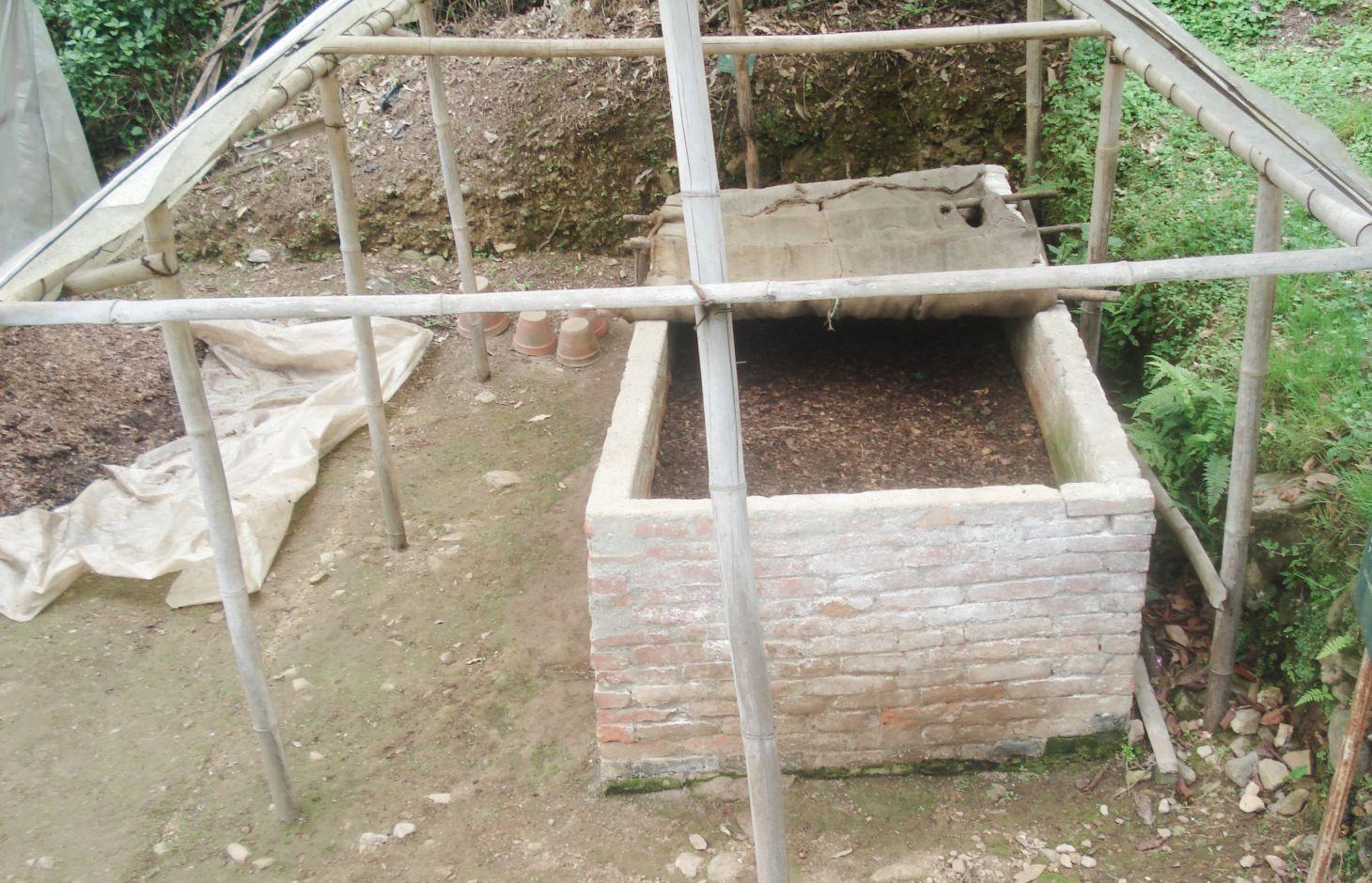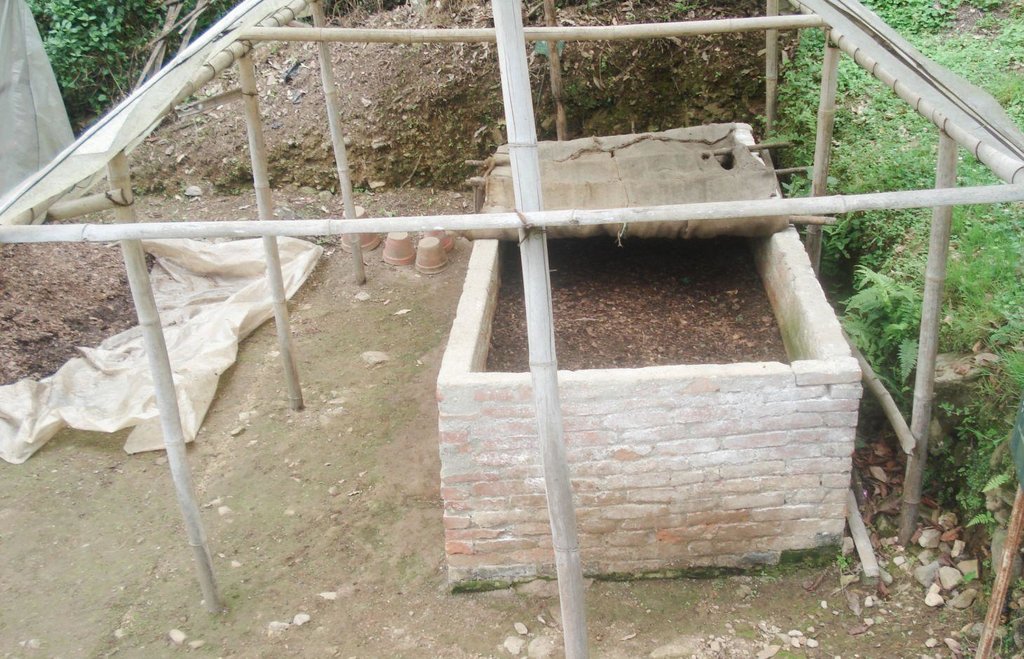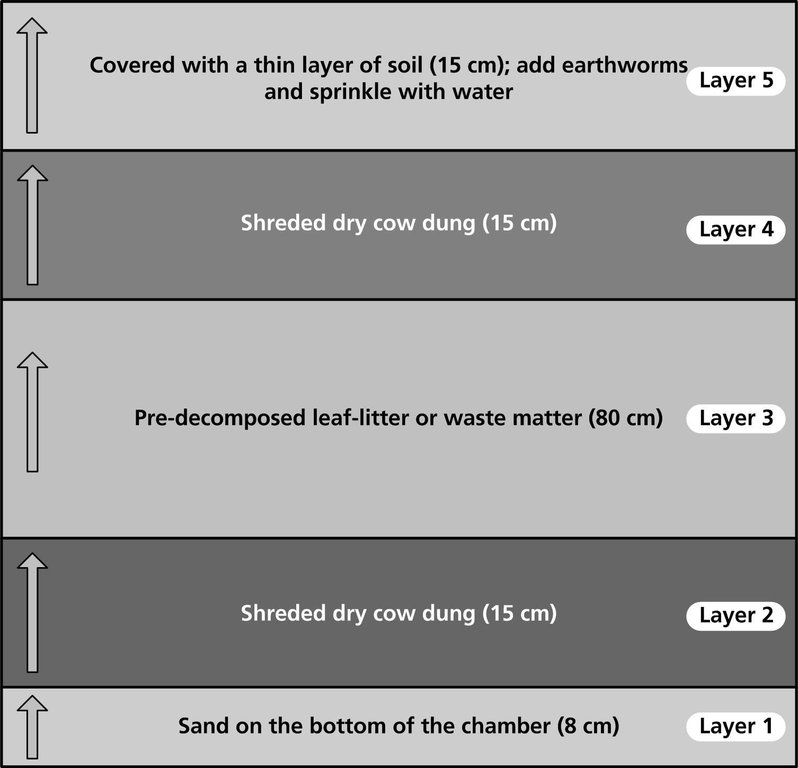Vermicomposting [เนปาล]
- ผู้สร้างสรรค์:
- การอัพเดท:
- ผู้รวบรวม: Shreedip Sigdel
- ผู้เรียบเรียง: –
- ผู้ตรวจสอบ: David Streiff
Gadaula proyog gari mal banaune prabidhi (Main Contributor: Samden Sherpa, ICIMOD)
technologies_1695 - เนปาล
ดูส่วนย่อย
ขยายทั้งหมด ย่อทั้งหมด1. ข้อมูลทั่วไป
1.2 รายละเอียดที่ติดต่อได้ของผู้รวบรวมและองค์กรที่เกี่ยวข้องในการประเมินและการจัดเตรียมทำเอกสารของเทคโนโลยี
ผู้เชี่ยวชาญ SLM:
Sherpa Samden Lama
+977 1 5003222
ssherpa@icimod.org
ICIMOD
P.O.Box 3226, Kathmandu, Nepal
เนปาล
ชื่อขององค์กรซึ่งอำนวยความสะดวกในการทำเอกสารหรือการประเมินเทคโนโลยี (ถ้าเกี่ยวข้อง)
ICIMOD International Centre for Integrated Mountain Development (ICIMOD) - เนปาล1.3 เงื่อนไขการใช้ข้อมูลที่ได้บันทึกผ่านทาง WOCAT
วันที่เก็บรวบรวมข้อมูล(ภาคสนาม) :
01/03/2013
ผู้รวบรวมและวิทยากรหลักยอมรับเงื่อนไขเกี่ยวกับการใช้ข้อมูลที่ถูกบันทึกผ่านทาง WOCAT:
ใช่
2. การอธิบายลักษณะของเทคโนโลยี SLM
2.1 การอธิบายแบบสั้น ๆ ของเทคโนโลยี
คำจำกัดความของเทคโนโลยี:
Vermicomposting or worm composting is a simple technology for converting biodegradable waste into organic manure with the help of earthworms.
2.2 การอธิบายแบบละเอียดของเทคโนโลยี
คำอธิบาย:
Earthworms are valued by farmers because, in addition to aerating the soil, they digest organic matter and produce castings that are a valuable source of humus. Vermicomposting, or worm composting is a simple technology that takes advantage of this to convert biodegradable waste into organic manure with the help of earthworms (the red worm Eisenia foetida) with no pile turning, no smell, and fast production of compost. The earthworms are bred in a mix of cow dung, soil, and agricultural residues or predecomposed leaf-litter. The whole mass is converted into casts or vermicompost, which can be used as a fertilizer on all types of plants in vegetable beds, landscaping areas, or lawns.
Purpose of the Technology: Worms are so effective at processing organic waste that they can digest almost half their own weight in debris every day. Vermicomposting is a simple composting process that takes advantage of what earthworms do naturally, but confines the worms to bins making it easier for farmers to feed them and to harvest their nutrient-rich compost. Since all worms digest organic matter, in principle, any type of worm can be used; however, not all are equally well adapted to living in bins since some worms prefer to live deep in the soil while others are better adapted to living closer to the surface. The red worm (Eisenia foetida) is ideal for vermicomposting because its natural habitat is close to the surface and it is accustomed to a diet rich in organic matter, this makes it ideally suited to digesting kitchen scraps and to living in bins.
Establishment / maintenance activities and inputs: Vermicomposting can be carried out in different types of containers. There are only a few requirements for a good worm pit, the most important being good ventilation; the pit needs to have more surface area than depth (wide and shallow) and it needs to have relatively low sides. The base of the worm pit is prepared with a layer of sand then alternating layers of shredded dry cow dung and degradable dry biomass and soil are added. Under ideal conditions, 1,000 earthworms can covert 45 kg of wet biomass per week into about 25 kg of vermicompost.
Natural / human environment: Worm castings contain five times more nitrogen, seven times more phosphorous, and eleven times more potassium than ordinary soil, the main minerals needed for plant growth. The vermicompost is so rich in nutrients that it should be mixed 1:4 with soil for plants to be grown in pots and containers. Vermicompost should not be allowed to dry out before using.
Note: This type of vermicomposting is sometimes referred to as 'Pusa' vermicomposting because it was popularized in South Asia by the Rajendra Agricultural University located in Pusa, Bihar, India.
2.3 รูปภาพของเทคโนโลยี
2.5 ประเทศภูมิภาค หรือสถานที่ตั้งที่เทคโนโลยีได้นำไปใช้และได้รับการครอบคลุมโดยการประเมินนี้
ประเทศ:
เนปาล
ข้อมูลจำเพาะเพิ่มเติมของสถานที่ตั้ง :
Godavari, Lalitpur District
2.7 คำแนะนำของเทคโนโลยี
ให้ระบุว่าเทคโนโลยีถูกแนะนำเข้ามาอย่างไร:
- ในช่วงการทดลองหรือการทำวิจัย
- ทางโครงการหรือจากภายนอก
3. การจัดประเภทของเทคโนโลยี SLM
3.1 วัตถุประสงค์หลักของเทคโนโลยี
- Improve fertilizer
3.2 ประเภทของการใช้ที่ดินในปัจจุบันที่ได้นำเทคโนโลยีไปใช้

พื้นที่ปลูกพืช
- การปลูกพืชล้มลุกอายุปีเดียว
- การปลูกพืชยืนต้นที่ไม่มีเนื้อไม้
แสดงความคิดเห็น:
Major land use problems (compiler’s opinion): Crop productivity is limited by poor soil fertility, intense cropping, and a scarcity of irrigation water. Farmers notice a marked decrease in the health of their crops and degraded soil conditions when chemical fertilizers are overused. Vermicomposting is a low input response to this problem.
Forest products and services: fuelwood
Other forest products and services: fodder
3.4 กลุ่ม SLM ที่ตรงกับเทคโนโลยีนี้
- การจัดการความอุดมสมบรูณ์ของดินแบบผสมผสาน
- การจัดการของเสีย / การจัดการน้ำเสีย
3.5 กระจายตัวของเทคโนโลยี
ระบุการกระจายตัวของเทคโนโลยี:
- ใช้ ณ จุดที่เฉพาะเจาะจงหรือเน้นไปยังบริเวณพื้นที่ขนาดเล็ก
3.6 มาตรการ SLM ที่ประกอบกันเป็นเทคโนโลยี

มาตรการจัดการพืช
- A2: อินทรียวัตถุในดิน/ความอุดมสมบูรณ์ในดิน
3.7 รูปแบบหลักของการเสื่อมโทรมของที่ดินที่ได้รับการแก้ไขโดยเทคโนโลยี

การเสื่อมโทรมของดินทางด้านเคมี
- Cn (Fertility decline): ความอุดมสมบูรณ์และปริมาณอินทรียวัตถุในดินถูกทำให้ลดลงไป (ไม่ได้เกิดจากสาเหตุการกัดกร่อน)
แสดงความคิดเห็น:
Main causes of degradation: soil management
3.8 การป้องกัน การลดลง หรือการฟื้นฟูความเสื่อมโทรมของที่ดิน
ระบุเป้าหมายของเทคโนโลยีกับความเสื่อมโทรมของที่ดิน:
- ป้องกันความเสื่อมโทรมของที่ดิน
4. ข้อมูลจำเพาะด้านเทคนิค กิจกรรมการนำไปปฏิบัติใช้ ปัจจัยนำเข้า และค่าใช้จ่าย
4.1 แบบแปลนทางเทคนิคของเทคโนโลยี
4.2 ข้อมูลจำเพาะด้านเทคนิคและการอธิบายแบบแปลนทางเทคนิค
Establishing a vermicompost pit
Diagram showing the layers needed to set up a vermicompost pit. Note that the middle layer is the thickest; the worms start here and eat both upwards and downwards. It is best to house the pit under a thatched or plastic roof in order to shield it from excessive sunshine and rain.
Technical knowledge required for field staff / advisors: moderate
Technical knowledge required for land users: moderate
Main technical functions: increase in nutrient availability (supply, recycling,…), Improve Soil Fertility
Secondary technical functions: improvement of topsoil structure (compaction), Stabilizes that soil
4.3 ข้อมูลทั่วไปเกี่ยวกับการคำนวณปัจจัยนำเข้าและค่าใช้จ่าย
ให้ระบุว่าค่าใช้จ่ายและปัจจัยนำเข้าได้รับการคำนวณอย่างไร:
- ต่อหน่วยเทคโนโลยี
โปรดระบุหน่วย:
worm pit
ระบุปริมาตร ความยาว เป็นต้น (ถ้าเกี่ยวข้อง):
A typical outdoor pit can measure 4 m long, 1 m wide and 0.75 m high
ระบุสกุลเงินที่ใช้คำนวณค่าใช้จ่าย:
- ดอลลาร์สหรัฐ
4.4 กิจกรรมเพื่อการจัดตั้ง
| กิจกรรม | ประเภทของมาตรการ | ช่วงเวลาดำเนินการ | |
|---|---|---|---|
| 1. | A low cost pit can be constructed with bricks on a moist or shaded site | ||
| 2. | If bricks are not available, stones can be used for the pit construction; | ||
| 3. | alternatively, a wooden or bamboo box or a plastic tray can also be used. | ||
| 4. | Vermicompost pits are best started during the summer months. | ||
| 5. | A thatched roof was built over the pit to help retain moisture in the heap | ||
| 6. | at a level of approximately 40–50%, as well as to maintain an optimal temperature of about 20–30oC. | ||
| 7. | Sand, soil, cow dung, and leaf litter are piled up as shown in the diagram. | ||
| 8. | Material Used are Bricks and cement, dry cow dung, plastic sheet/bamboo, earthworm (around 2000) |
4.5 ค่าใช้จ่ายของปัจจัยนำเข้าที่จำเป็นสำหรับการจัดตั้ง
| ปัจจัยนำเข้า | หน่วย | ปริมาณ | ค่าใช้จ่ายต่อหน่วย | ค่าใช้จ่ายทั้งหมดต่อปัจจัยนำเข้า | %ของค่าใช้จ่ายที่ก่อให้เกิดขึ้นโดยผู้ใช้ที่ดิน | |
|---|---|---|---|---|---|---|
| แรงงาน | Construction of pit | persons/day/unit | 10.0 | 5.0 | 50.0 | |
| วัสดุสำหรับก่อสร้าง | Brick and cement | unit | 1.0 | 70.0 | 70.0 | |
| วัสดุสำหรับก่อสร้าง | Dry cow dung | unit | 1.0 | 10.0 | 10.0 | |
| วัสดุสำหรับก่อสร้าง | Plastic sheet/bamboo | unit | 1.0 | 70.0 | 70.0 | |
| วัสดุสำหรับก่อสร้าง | Earthworm (2000) | unit | 1.0 | 60.0 | 60.0 | |
| ค่าใช้จ่ายทั้งหมดของการจัดตั้งเทคโนโลยี | 260.0 | |||||
แสดงความคิดเห็น:
Duration of establishment phase: 3 month(s)
4.6 การบำรุงรักษาสภาพหรือกิจกรรมที่เกิดขึ้นเป็นประจำ
| กิจกรรม | ประเภทของมาตรการ | ช่วงระยะเวลา/ความถี่ | |
|---|---|---|---|
| 1. | Water regularly and collect, harvest vermicompost | จัดการพืช | |
| 2. | The pit is watered regularly. After five to six weeks, the top layer is removed and piled in one corner of the pit. After a few days, the worms will have borrowed down to the bottom of this pile and the compost can be harvested. The compost prepared in the pit should be harvested within 6 months and the pit refurbished as for the first set as discussed above. | จัดการพืช |
4.7 ค่าใช้จ่ายของปัจจัยนำเข้าและกิจกรรมที่เกิดขึ้นเป็นประจำที่ต้องการการบำรุงรักษา (ต่อปี)
| ปัจจัยนำเข้า | หน่วย | ปริมาณ | ค่าใช้จ่ายต่อหน่วย | ค่าใช้จ่ายทั้งหมดต่อปัจจัยนำเข้า | %ของค่าใช้จ่ายที่ก่อให้เกิดขึ้นโดยผู้ใช้ที่ดิน | |
|---|---|---|---|---|---|---|
| แรงงาน | Watering pit | persons/day/unit | 5.0 | 5.0 | 25.0 | |
| วัสดุสำหรับก่อสร้าง | Dry cow dung | unit | 1.0 | 5.0 | 5.0 | |
| วัสดุสำหรับก่อสร้าง | Water pipe | unit | 1.0 | 10.0 | 10.0 | |
| ค่าใช้จ่ายทั้งหมดของการบำรุงรักษาสภาพเทคโนโลยี | 40.0 | |||||
4.8 ปัจจัยสำคัญที่สุดที่มีผลกระทบต่อค่าใช้จ่าย
ปัจจัยสำคัญที่สุดที่มีผลกระทบต่อค่าใช้จ่ายต่างๆ:
All costs and amounts are rough estimates by the technicians and authors. This was a demonstration project conducted by ICIMOD.
5. สิ่งแวดล้อมทางธรรมชาติและของมนุษย์
5.1 ภูมิอากาศ
ฝนประจำปี
- < 250 ม.ม.
- 251-500 ม.ม.
- 501-750 ม.ม.
- 751-1,000 ม.ม.
- 1,001-1,500 ม.ม.
- 1,501-2,000 ม.ม.
- 2,001-3,000 ม.ม.
- 3,001-4,000 ม.ม.
- > 4,000 ม.ม.
เขตภูมิอากาศเกษตร
- กึ่งชุ่มชื้น
Thermal climate class: temperate
5.2 สภาพภูมิประเทศ
ค่าเฉลี่ยความลาดชัน:
- ราบเรียบ (0-2%)
- ลาดที่ไม่ชัน (3-5%)
- ปานกลาง (6-10%)
- เป็นลูกคลื่น (11-15%)
- เป็นเนิน (16-30%)
- ชัน (31-60%)
- ชันมาก (>60%)
ธรณีสัณฐาน:
- ที่ราบสูง/ที่ราบ
- สันเขา
- ไหล่เขา
- ไหล่เนินเขา
- ตีนเนิน
- หุบเขา
ระดับความสูง:
- 0-100 เมตร
- 101-500 เมตร
- 501-1,000 เมตร
- 1,001-1,500 เมตร
- 1,501-2,000 เมตร
- 2,001-2,500 เมตร
- 2,501-3,000 เมตร
- 3,001-4,000 เมตร
- > 4,000 เมตร
5.3 ดิน
ค่าเฉลี่ยความลึกของดิน:
- ตื้นมาก (0-20 ซ.ม.)
- ตื้น (21-50 ซ.ม.)
- ลึกปานกลาง (51-80 ซ.ม.)
- ลึก (81-120 ซ.ม.)
- ลึกมาก (>120 ซ.ม.)
เนื้อดิน (ดินชั้นบน):
- ปานกลาง (ดินร่วน ทรายแป้ง)
อินทรียวัตถุในดิน:
- สูง (>3%)
(ถ้ามี) ให้แนบคำอธิบายเรื่องดินแบบเต็มหรือระบุข้อมูลที่มีอยู่ เช่น ชนิดของดิน ค่า pH ของดินหรือความเป็นกรดของดิน ความสามารถในการแลกเปลี่ยนประจุบวก ไนโตรเจน ความเค็ม เป็นต้น:
Soil fertility is medium
Soil drainage / infiltration is medium
Soil water storage capacity is medium
5.4 ความเป็นประโยชน์และคุณภาพของน้ำ
ระดับน้ำใต้ดิน:
<5 เมตร
น้ำไหลบ่าที่ผิวดิน:
ดี
คุณภาพน้ำ (ที่ยังไม่ได้บำบัด):
เป็นน้ำเพื่อการดื่มที่ดี
ความคิดเห็นและข้อมูลจำเพาะเพิ่มเติมเรื่องคุณภาพและปริมาณน้ำ:
Water quality (untreated): Also for agricultural use (irrigation)
5.5 ความหลากหลายทางชีวภาพ
ความหลากหลายทางชนิดพันธุ์:
- สูง
ความคิดเห็นและข้อมูลจำเพาะเพิ่มเติมของความหลากหลายทางชีวภาพ:
695 species of flora and 230 species of fauna have been documented within the Park's 30 ha area
5.6 ลักษณะของผู้ใช้ที่ดินที่นำเทคโนโลยีไปปฏิบัติใช้
แนวทางการตลาดของระบบการผลิต:
- ผสม (การเลี้ยงชีพ/ทำการค้า)
รายได้ที่มาจากนอกฟาร์ม:
- > 50% ของรายได้ทั้งหมด
ระดับของความมั่งคั่งโดยเปรียบเทียบ:
- จน
ระดับของการใช้เครื่องจักรกล:
- งานที่ใช้แรงกาย
- การใช้กำลังจากสัตว์
ระบุลักษณะอื่นๆที่เกี่ยวข้องของผู้ใช้ที่ดิน:
Population density: < 10 persons/km2
5.7 พื้นที่เฉลี่ยของที่ดินที่เป็นเจ้าของหรือเช่าโดยผู้ใช้ที่ดินที่นำเทคโนโลยีไปปฏิบัติใช้
- < 0.5 เฮกตาร์
- 0.5-1 เฮกตาร์
- 1-2 เฮกตาร์
- 2-5 เฮกตาร์
- 5-15 เฮกตาร์
- 15-50 เฮกตาร์
- 50-100 เฮกตาร์
- 100-500 เฮกตาร์
- 500-1,000 เฮกตาร์
- 1,000-10,000 เฮกตาร์
- >10,000 เฮกตาร์
5.8 กรรมสิทธิ์ในที่ดิน สิทธิในการใช้ที่ดินและสิทธิในการใช้น้ำ
- Governement
- ICIMOD
- ICIMOD
5.9 การเข้าถึงบริการและโครงสร้างพื้นฐาน
ถนนและการขนส่ง:
- จน
- ปานกลาง
- ดี
labour:
- จน
- ปานกลาง
- ดี
6. ผลกระทบและสรุปคำบอกกล่าว
6.1 ผลกระทบในพื้นที่ดำเนินการ (On-site) จากการใช้เทคโนโลยี
ผลกระทบทางด้านเศรษฐกิจและสังคม
รายได้และค่าใช้จ่าย
ค่าใช่จ่ายของปัจจัยการผลิตทางการเกษตร
ภาระงาน
แสดงความคิดเห็น/ระบุ:
The vermicompost pit needs to be watered and maintained regularly
ผลกระทบทางด้านเศรษฐกิจและสังคมอื่น ๆ
Earthworms need to be purchased from outside
ผลกระทบด้านสังคมวัฒนธรรมอื่น ๆ
livelihood and human well-being
แสดงความคิดเห็น/ระบุ:
Provides employment opportunities. Quality compost helps to improve the soil and increases crop production
ผลกระทบด้านนิเวศวิทยา
ผลกระทบด้านนิเวศวิทยาอื่น ๆ
soil fertility
can be used to produce organic crops
use of chemical fertilizer
6.2 ผลกระทบนอกพื้นที่ดำเนินการ (Off-site) จากการใช้เทคโนโลยี
dependency on external inputs
6.3 การเผชิญและความตอบสนองของเทคโนโลยีต่อการเปลี่ยนแปลงสภาพภูมิอากาศที่ค่อยเป็นค่อยไป และสภาพรุนแรงของภูมิอากาศ / ภัยพิบัติ (ที่รับรู้ได้โดยผู้ใช้ที่ดิน)
ผลลัพธ์ตามมาที่เกี่ยวข้องกับภูมิอากาศอื่น ๆ
ผลลัพธ์ตามมาที่เกี่ยวข้องกับภูมิอากาศอื่น ๆ
| เทคโนโลยีมีวิธีการรับมืออย่างไร | |
|---|---|
| active in warm climate | ดี |
6.4 การวิเคราะห์ค่าใช้จ่ายและผลประโยชน์ที่ได้รับ
ผลประโยชน์ที่ได้รับเปรียบเทียบกับค่าใช้จ่ายในการจัดตั้งเป็นอย่างไร (จากมุมมองของผู้ใช้ที่ดิน)
ผลตอบแทนระยะสั้น:
ด้านบวก
ผลตอบแทนระยะยาว:
ด้านบวก
ผลประโยชน์ที่ได้รับเปรียบเทียบกับค่าใช้จ่ายในการบำรุงรักษาหรือต้นทุนที่เกิดขึ้นซ้ำอีก เป็นอย่างไร (จากมุมมองของผู้ใช้ที่ดิน)
ผลตอบแทนระยะสั้น:
ด้านบวก
ผลตอบแทนระยะยาว:
ด้านบวก
6.5 การปรับตัวของเทคโนโลยี
แสดงความคิดเห็น:
There is a strong trend towards spontaneous adoption of the Technology
Comments on adoption trend: Vermicomposting training was provided to farmers in Nuwakot, Rasuwa, Godavari, and Bishankhunarayan VDCs by ICIMOD staff in collaboration with local NGOs. More than 60% of the farmers who received training adopted vermicomposting on their own farms and they have also started selling worms to other farmers. The technology has been adopted by others who have visited the ICIMOD Knowledge Park at Godavari but most of these are just interested in introducing it on a small scale, such as, to produce vermicompost from kitchen waste for household use in their own gardens. The participants were also taught how to collect local earthworms to use for composting.
Drivers of adaptation of the technology
• A simple technology and easy to implement
• Local earthworms can be used.
• Not expensive; farmers can construct pits or uses wooden boxes or plastic trays.
• Produces high quality compost with a high concentration of nutrients
• Helps to reduce pests in the soil
• Can be scaled up to produce compost commercially
6.7 จุดแข็ง / ข้อได้เปรียบ / โอกาสของเทคโนโลยี
| จุดแข็ง / ข้อได้เปรียบ / โอกาสในทัศนคติของผู้รวบรวมหรือวิทยากรหลัก |
|---|
|
The use of vermicompost reduces the need for chemical fertilizers and reduces dependence on outside sources. How can they be sustained / enhanced? Promote the technology by disseminating it to a large number of farmers on both small and big farms |
|
Vermicomposting does not require keeping livestock. How can they be sustained / enhanced? It is considered to be a low-cost alternative that uses local earthworms and materials to produce compost. |
| On-farm composting saves the transportation cost needed to deliver compost to the farm. |
6.8 จุดอ่อน / ข้อเสียเปรียบ / ความเสี่ยงของเทคโนโลยีและวิธีการแก้ไข
| จุดอ่อน / ข้อเสียเปรียบ / ความเสี่ยงในทัศนคติของผู้รวบรวมหรือวิทยากรหลัก | มีวิธีการแก้ไขได้อย่างไร |
|---|---|
| Purchasing earthworms from outside may be expensive for farmers. | Farmers can be encouraged to harvest local earthworms for composting. |
| Making compost from earthworms is not very popular in rural areas. | Create greater awareness on how earthworms can be used to compost leaf-litter and other kitchen waste. |
7. การอ้างอิงและการเชื่อมต่อ
7.3 เชื่อมโยงกับข้อมูลที่มีอยู่บนออนไลน์
ชื่อเรื่องหรือคำอธิบาย:
Vermicomposting: Journey to forever organic garden (no date)
URL:
http://journeytoforever.org/compost_worm.html
ลิงก์และโมดูล
ขยายทั้งหมด ย่อทั้งหมดลิงก์
ไม่มีลิงก์
โมดูล
ไม่มีโมดูล





